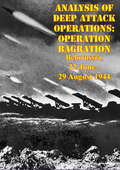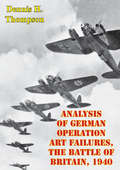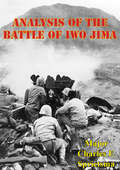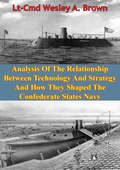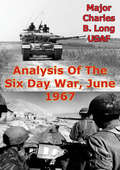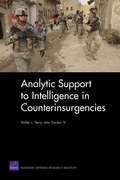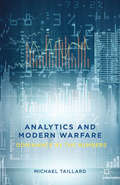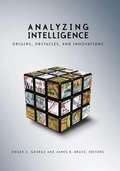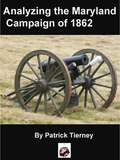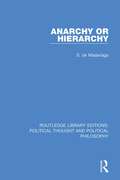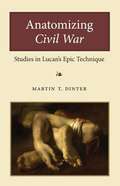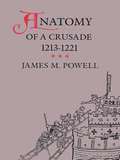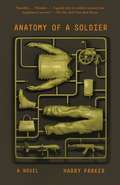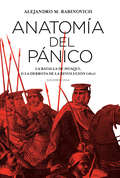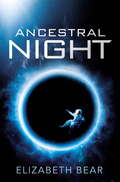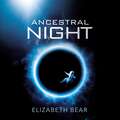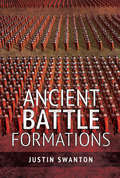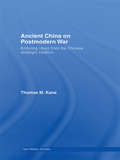- Table View
- List View
Analysis Of Deep Attack Operations: Operation Bagration, Belorussia, 22 June - 29 August 1944 [Illustrated Edition]
by Lieutenant Colonel William M. ConnorIncludes the World War Two On The Eastern Front (1941-1945) Illustration Pack - 198 photos/illustrations and 46 maps.Operation BAGRATION took place during what the Soviet analysts consider the third period of the war: that of the Soviet strategic offensives which marked the ascendancy of the Soviet armed forces over the German Wehrmacht. During this period, the armed forces of the Soviet Union held the strategic initiative and used it to defeat the Wehrmacht, gain control of Eastern Europe, and invade Germany proper, meeting Allied forces on the Elbe River on 25 April 1945. The period is regarded as beginning Jan. 1944 and ending with the V-E Day, 7 May 1945.By the beginning of 1944, the Red Army clearly had the initiative on the Eastern Front; moreover, since the beginning of the second period, the Soviet Union also had strong allies who could provide assistance in two ways: the U.S. and Great Britain...The invasions of Sicily and Italy followed in the second period, knocking Italy out of its alliance with Germany and diverting German forces to defend in Italy. The invasion of Sicily may also have contributed to the German decision to break off its Kursk offensives as well in July 1943...In the third period of the war, therefore, the Soviet Union held the strategic initiative, and the year opened with the first two of what would come to be known as the "Ten Destructive Blows" of 1944: Leningrad and the Ukraine. The offensive at Leningrad commenced on 14 Jan. 1944 and ground to a halt on 1 March with the German siege of Leningrad broken, the German Sixteenth and Eighteenth Armies defeated, Soviet advances of up to 200 kilometers, and Soviet forces on the border of Estonia. The blow in the Ukraine commenced on 24 Jan. 1944, lasting until mid-April, and involved all of the fronts in the Ukraine. Finally, the various fronts were ordered by Stavka to go on the defensive between 17 April and 6 May to prepare for the summer offensive.
Analysis Of Engineering Design Studies For Demilitarization Of Assembled Chemical Weapons At Blue Grass Army Depot
by National Research Council of the National AcademiesThe Program Manager for Assembled Chemical Weapons Assessment (PMACWA) of the Department of Defense (DOD) requested the National Research Council (NRC) to assess the engineering design studies (EDSs) developed by Parsons/Honeywell and General Atomics for a chemical demilitarization facility to completely dispose of the assembled chemical weapons at the Pueblo Chemical Depot in Pueblo, Colorado. To accomplish the task, the NRC formed the Committee on Review and Evaluation of Alternative Technologies for Demilitarization of Assembled Chemical Weapons: Phase II (ACW II Committee). This report presents the results of the committee's scientific and technical assessment, which will assist the Office of the Secretary of Defense in selecting the technology package for destroying the chemical munitions at Pueblo.
Analysis Of German Operation Art Failures, The Battle Of Britain, 1940
by Lieutenant Colonel John TurnerThe Battle of Britain was the first major defeat for the Germans of WWII. The Battle of Britain was an air operation designed to give Germany air superiority over both the English Channel and England. Gaining air superiority was considered by the Germany Army and Navy as absolutely essential prior to "Operation Sea Lion," the landing and invasion of England. Because the Luftwaffe was never able to establish the requisite air superiority, Sea Lion was cancelled.This paper examines the German Operational Art issues from a historical perspective. It concludes the failure of the Luftwaffe belongs to Reich-Marshall Goring, operational commander for the Battle of Britain. His main failure, as operational commander, was repeatedly making tactical decisions from the operational level rather than leaving this to on-the-scene tactical commanders. Secondly, he was never able to identify Fighter Command as the British Center of Gravity. Thirdly, he never understood the intelligence advantage gained by the British as a result of their newly invented radar early warning system. As a result, Germany lost the battle.
Analysis Of The Battle Of Iwo Jima
by Major Charles F. Sprietsma"Among Americans who served on Iwo Island, uncommon valor was a common virtue". This statement by Fleet Admiral Nimitz following the Battle of Iwo Jima succinctly summarizes the degree of effort, dedication, and personal sacrifice required of American servicemen to capture the island. The Japanese defenders also displayed these qualities, but the United States forces prevailed because they combined this effort, dedication, and sacrifice with superior application of basic principles of warfighting. Analysis of the application of these principles will help us understand why the battle developed and ended as it did. To do this, we must first examine the battle itself.
Analysis Of The Relationship Between Technology And Strategy And How They Shaped The Confederate States Navy [Illustrated Edition]
by Lt-Cmd Wesley A. BrownIncludes 23 illustrations and 3 tables.This study investigates the use of technology by the Confederate States of America to develop naval strategy and ultimately the Navy during the American Civil War. The study concentrates on the building and use of: ironclads to break the blockade and coastal defense, torpedoes (mines) for coastal defense, and Submarines to help break the blockade at Charleston.The use of technology had a significant influence on the Confederate Navy not only on the strategic, but also on the operational and the tactical levels of war. Operational campaigns were planned and executed around the presence or absence of confederate ironclads by both the North and the South. Battles were won, lost, or never fought due to the presence of confederate torpedoes laid in Southern harbors. The threat of Confederate submarines caused Union blockading squadrons to reduce the capabilities of catching runners by moving the fleet out of the submarines tactical range.Today's Navy, in its quest for new technology, faces a similar situation as the Confederate Navy did in 1861. The Navy must seek new technology to enhance warfighting skills and not simply look for the "ultimate weapon," as the Confederate Navy first thought of the ironclad.
Analysis Of The Six Day War, June 1967
by Major Charles B. Long USAFThis paper examines the Six Day War, the Arab-Israeli conflict of 1967, for the purposes of highlighting applications/violations of the principles of war outlined in AFM 1-1. This material will be incorporated into an AGSC block of instruction studying the principles of war as used in famous historical battles. This paper is divided into three separate sections. The first section reviews the background of the Arab-Israeli problem and highlights some of the major events leading up to the war. This section also presents a battle synopsis of the conflict including visual depictions of the battle progress. The second section provides an analysis of the use (or misuse) of the principles of war by each side--Arab and Israeli. The final section provides some discussion questions, with supporting rationale, in a guided discussion format for possible use in a seminar environment. The non-standard format for this project is at the request of ACSC/EDCJ to assist in building this particular block of instruction.
Analytic Support to Intelligence in Counterinsurgencies
by Walter L. Perry John GordonOperations in Iraq and Afghanistan have shown that U.S. forces need more-effective techniques and procedures to conduct counterinsurgency. They will most likely face similar, irregular warfare tactics from future enemies. This monograph examines the nature of the contemporary insurgent threat and provides insights on using operational analysis techniques to support intelligence operations in counterinsurgencies.
Analytics And Modern Warfare: Dominance by the Numbers
by Michael TaillardThis book details very simply and for even the most novice of potential analysts not only how to perform analytics which describe what is happening, predict what is going to happen, and optimize responses, but also places these analytics in the context of proactive strategy development.
Analyzing Intelligence: Origins, Obstacles, and Innovations
by Roger Z. George James B. BruceDrawing on the individual and collective experience of recognized intelligence experts and scholars in the field, Analyzing Intelligence provides the first comprehensive assessment of the state of intelligence analysis since 9/11. Its in-depth and balanced evaluation of more than fifty years of U. S. analysis includes a critique of why it has under-performed at times. It provides insights regarding the enduring obstacles as well as new challenges of analysis in the post-9/11 world, and suggests innovative ideas for improved analytical methods, training, and structured approaches. The book's six sections present a coherent plan for improving analysis. Early chapters examine how intelligence analysis has evolved since its origins in the mid-20th century, focusing on traditions, culture, successes, and failures. The middle sections examine how analysis supports the most senior national security and military policymakers and strategists, and how analysts must deal with the perennial challenges of collection, politicization, analytical bias, knowledge building and denial and deception. The final sections of the book propose new ways to address enduring issues in warning analysis, methodology (or "analytical tradecraft") and emerging analytic issues like homeland defense. The book suggests new forms of analytic collaboration in a global intelligence environment, and imperatives for the development of a new profession of intelligence analysis. Analyzing Intelligence is written for the national security expert who needs to understand the role of intelligence and its strengths and weaknesses. Practicing and future analysts will also find that its attention to the enduring challenges provides useful lessons-learned to guide their own efforts. The innovations section will provoke senior intelligence managers to consider major changes in the way analysis is currently organized and conducted, and the way that analysts are trained and perform.
Analyzing the Maryland Campaign of 1862
by Patrick TierneyA short analysis of the decisions and actions that led to Gen Lee's invasion of Maryland in 1862
Anarchy In The Ashes (Ashes #3)
by William W. JohnstoneAn ex-soldier who rebuilt America after nuclear holocaust now faces a Russian invasion in this action-packed adventure from a USA Today–bestselling author. In the aftermath of germ and nuclear warfare, of plague and pillage and bloody anarchy, the fate of a divided world hangs by a slender thread. Ben Raines and his SUSA Rebels are on one side and the enemies of freedom are on the other. But Ben Raines has sworn to make the dream of government by the people a reality. That is until ruthless mercenary Sam Hartline puts together a mammoth army of invading Russians that could not only decimate Raines's Rebel forces but forever crush the dream that was—and is—America. Third in the long-running series!
Anarchy or Hierarchy (Routledge Library Editions: Political Thought and Political Philosophy #36)
by S. de MadariagaOriginally published in 1937 during the Spanish Civil War, the country was split into pro-fascists and pro-communists, the author felt that the conflict in Spain threatened to develop into an international war, perhaps an international civil war since the issue cut across frontier lines. The situation had no parallel at the time. The author looks back to wars of the sixteenth century to find a precedent for this dramatic duel between two political conceptions. Using examples from Europe including the conflict between Catholics and Protestants he shows that, as in England who led their own way at the time, there are alternative solutions and hopefully a way to find a middle ground.
Anatomizing Civil War: Studies in Lucan's Epic Technique
by Martin T. DinterImperial Latin epic has seen a renaissance of scholarly interest. This book illuminates the work of the poet Lucan, a contemporary of the emperor Nero who as nephew of the imperial adviser Seneca moved in the upper echelons of Neronian society. This young and maverick poet, whom Nero commanded to commit suicide at the age of 26, left an epic poem on the civil war between Caesar and Pompey that epitomizes the exuberance and stylistic experimentation of Neronian culture. This study focuses on Lucan's epic technique and traces his influence through the Middle Ages and the Renaissance. Martin T. Dinter's newest volume engages with Lucan's use of body imagery, sententiae, Fama (rumor), and open-endedness throughout his civil war epic. Although Lucan's Bellum Civile is frequently decried as a fragmented as well as fragmentary epic, this study demonstrates how Lucan uses devices other than teleology and cohesive narrative structure to bind together the many parts of his epic body. Anatomizing Civil War places at center stage characteristics of Lucan's work that have so far been interpreted as excessive, or as symptoms of an overly rhetorical culture indicating a lack of substance. By demonstrating that they all contribute to Lucan's poetic technique, Martin T. Dinter shows how they play a fundamental role in shaping and connecting the many episodes of the Bellum Civile that constitute Lucan's epic body. This important volume will be of interest to students of classics and comparative literature as well as literary scholars. All Greek and Latin passages have been translated.
Anatomy of a Crusade, 1213-1221
by James M. PowellJames M. Powell here offers a new interpretation of the Fifth Crusade's historical and social impact, and a richly rewarding view of life in the thirteenth century. Powell addresses such questions as the degree of popular interest in the crusades, the religious climate of the period, the social structure of the membership of the crusade, and the effects of the recruitment effort on the outcome.
Anatomy of a Genocide: The Life and Death of a Town Called Buczacz
by Omer BartovA fascinating and cautionary examination of how genocide can take root at the local level—turning neighbors, friends, and even family members against one another—as seen through the eastern European border town of Buczacz during World War II.For more than four hundred years, the Eastern European border town of Buczacz—today part of Ukraine—was home to a highly diverse citizenry. It was here that Poles, Ukrainians, and Jews all lived side by side in relative harmony. Then came World War II, and three years later the entire Jewish population had been murdered by German and Ukrainian police, while Ukrainian nationalists eradicated Polish residents. In truth, though, this genocide didn’t happen so quickly. In Anatomy of a Genocide Omer Bartov explains that ethnic cleansing doesn’t occur as is so often portrayed in popular history, with the quick ascent of a vitriolic political leader and the unleashing of military might. It begins in seeming peace, slowly and often unnoticed, the culmination of pent-up slights and grudges and indignities. The perpetrators aren’t just sociopathic soldiers. They are neighbors and friends and family. They are human beings, proud and angry and scared. They are also middle-aged men who come from elsewhere, often with their wives and children and parents, and settle into a life of bourgeois comfort peppered with bouts of mass murder: an island of normality floating on an ocean of blood. For more than two decades Bartov, whose mother was raised in Buczacz, traveled extensively throughout the region, scouring archives and amassing thousands of documents rarely seen until now. He has also made use of hundreds of first-person testimonies by victims, perpetrators, collaborators, and rescuers. Anatomy of a Genocide profoundly changes our understanding of the social dynamics of mass killing and the nature of the Holocaust as a whole. Bartov’s book isn’t just an attempt to understand what happened in the past. It’s a warning of how it could happen again, in our own towns and cities—much more easily than we might think.
Anatomy of a Soldier: A novel
by Harry ParkerAnatomy of a Soldier is a stunning first novel--of patriotism, heroism, and profound humanism--that will immediately take its place on the shelf of classics about what it truly means to be at war. Let's imagine a man called Captain Tom Barnes, aka BA5799, who's leading British troops in the war zone. And two boys growing up together there, sharing a prized bicycle and flying kites before finding themselves estranged once foreign soldiers appear in their countryside. And then there's the man who trains one of them to fight against the other's father and all these infidel invaders. Then imagine the family and friends who radiate out from these lives, people on all sides of this conflict where virtually everyone is caught up in the middle of something unthinkable. But then regard them not as they see themselves but as all the objects surrounding them do: shoes and boots, a helmet, a bag of fertilizer, a medal, a beer glass, a snowflake, dog tags, and a horrific improvised explosive device that binds them all together by blowing one of them apart--forty-five different narrators in all, including the multiple medical implements subsequently required to keep Captain Barnes alive. The result is a novel that reveals not only an author with a striking literary talent and intelligence but also the lives of people--whether husband or wife, father or mother, son or daughter--who are part of this same heart-stopping journey. A work of extraordinary humanity and hope, created out of something hopeless and dehumanizing, it makes art out of pain and suffering and takes its place in a long and rich line of novels that articulate the lives that soldiers lead. In the boom of an instant, and in decades of very different lives and experiences, we see things we've never understood so clearly before.From the Hardcover edition.
Anatomía del pánico: La batalla de Huaqui, o la derrota de la Revolución (1811)
by Alejandro RabinovichBasado en testimonios y documentos inéditos, Alejandro M. Rabinovich reconstruye de manera exhaustiva los pormenores de la batalla de Huaqui de 1811 y estudia en detalle las causas y las consecuencias de ese pánico que condujo a la pérdida del Alto Perú e hizo tambalear el futuro mismo de la Revolución. «Se pierde la acción del Desaguadero por la infamia de los abominables Castelli y Balcarce, y regresan las tropas dispersas y derrotadas, cometiendo en su tránsito los oficiales y soldados crímenes y atrocidades que sería difícil presumirse si no fuéramos testigos de su ejecución.»Miguel Otero (1812) La de Huaqui no fue una derrota más de las muchas que sufrió la Revolución. El ejército comandado por Castelli no fue vencido por la superioridad numérica del enemigo ni las bajas sufridas. Simplemente, en un momento dado, por algún motivo misterioso y en apariencia inexplicable, los 6.000 hombres que lo componían tiraron las armas, huyeron despavoridos y se internaron en cerros desconocidos para no salir sino días más tarde, después de haber cometido los más horrendos crímenes, marcados para siempre por una desbandada traumática. ¿Qué fue lo que pasó? ¿Qué hizo que esos oficiales y soldados enloquecieran de semejante modo? Los contemporáneos lo llamaron "pánico".
Ancestor's Footsteps: The Somme 1916
by Andrew RawsonThis book answers one of biggest unanswered questions asked by visitors to the Somme; where did my ancestor fight? The combination of First World War battle accounts and annotated trench maps throughout this book, explains exactly what happened and where, and indexed orders of battle give the reader a quick reference to locate individual units.But the book goes further than this as carefully chosen viewpoints, which are practical for anyone exploring in a car, have been suggested. They give the visitor different perspectives of the ground where their ancestors fought and died; and in many cases are buried in an unmarked grave.There is useful information on the structure of the British Army and the weapons, equipment and uniforms the men used. Information on the different methods of attacks used, the development of tactics and life in the trenches is also included. As well as this, there is a guide to the key cemeteries, memorials and museums the visitor should consider seeing to complete a visit.This book will help the casual visitor walk in their ancestors footsteps across the Somme battlefield. It will also guide the regular visitor across different areas of the battlefield, away from the popular points, and help all visitors accomplish the rewarding experience of connecting the battles of the past with the terrain of today.
Ancestral Night: A White Space Novel (White Space)
by Elizabeth BearA space salvager and her partner make the discovery of a lifetime that just might change the universe in this wild, big-ideas space opera from multi award-winning author Elizabeth Bear.Haimey Dz thinks she knows what she wants.She thinks she knows who she is.She is wrong.A routine salvage mission uncovers evidence of a terrible crime and relics of a powerful ancient technology, just as Haimey and her small crew run afoul of pirates at the outer limits of the Milky Way and find themselves both on the run, and in possession of ancient, universe-changing technology.When the authorities prove corrupt, it becomes clear that Haimey is the only one who can protect her galaxy-spanning civilisation from its potential power - and from the revolutionaries who want to use it to seed terror and war. But doing so will take her from the event horizon of the super-massive black hole at the galaxy's core to the infinite, empty spaces at its edge. Along the way, she'll have to uncover the secrets of ancient intelligences lost to time as well as her own lost secrets, which she will wish had remained hidden from her forever . . .Energetic and electrifying, Ancestral Night is a dazzling new space opera, sure to delight fans of Alastair Reynolds, Iain M. Banks, and Peter F. Hamilton.Praise for Elizabeth Bear'Gripping, perfectly balanced, and highly recommended' Kirkus'Like the best of speculative fiction, Bear has created a fascinating and complete universethat blends high-tech gadgetry with Old World adventure and political collusion' Publishers Weekly
Ancestral Night: A White Space Novel (White Space)
by Elizabeth BearA space salvager and her partner make the discovery of a lifetime that just might change the universe in this wild, big-ideas space opera from multi award-winning author Elizabeth Bear.Haimey Dz thinks she knows what she wants.She thinks she knows who she is.She is wrong.A routine salvage mission uncovers evidence of a terrible crime and relics of a powerful ancient technology, just as Haimey and her small crew run afoul of pirates at the outer limits of the Milky Way and find themselves both on the run, and in possession of ancient, universe-changing technology.When the authorities prove corrupt, it becomes clear that Haimey is the only one who can protect her galaxy-spanning civilisation from its potential power - and from the revolutionaries who want to use it to seed terror and war. But doing so will take her from the event horizon of the super-massive black hole at the galaxy's core to the infinite, empty spaces at its edge. Along the way, she'll have to uncover the secrets of ancient intelligences lost to time as well as her own lost secrets, which she will wish had remained hidden from her forever . . .Energetic and electrifying, Ancestral Night is a dazzling new space opera, sure to delight fans of Alastair Reynolds, Iain M. Banks, and Peter F. Hamilton.Praise for Elizabeth Bear'Gripping, perfectly balanced, and highly recommended' Kirkus'Like the best of speculative fiction, Bear has created a fascinating and complete universethat blends high-tech gadgetry with Old World adventure and political collusion' Publishers Weekly
Ancient Battle Formations
by Justin SwantonAn analysis of ancient Greek, Roman, and Macedonian winning battle formations, from why they worked, the equipment and men used, and how they broke down. Justin Swanton examines the principal battle-winning formations of the ancient world, determining their composition, function and efficacy. An introductory chapter looks at the fundamental components of the principal battle formations of heavy and light infantry, cavalry, elephants and chariots, showing how they bolstered the individual's soldier's willingness to fight. The rest of the book focuses on massed infantry that reigned supreme in this era: the heavily armored Greek hoplite phalanx that was immune to the weaponry of its non-Greek opponents; the Macedonian pike phalanx that was unbeatable against frontal attacks so long as it kept order; the Roman triplex acies which, contrary to popular opinion, consisted of continuous lines in open order, with file spaces wide enough to allow embattled infantry to fall back after which those files closed up instantly against the enemy. A careful study of the Greek and Latin of the sources sheds fresh light on how these formations were organized and worked, reevaluating many conventional notions and leading to some surprising conclusions.Praise for Ancient Battle Formations&“This book is both important for its thoroughly researched, original and well-argued historical conclusions and an enjoyable read. Highly recommended.&” —Professor F. Noel Zaal (BA, LLB University of Natal, LLM Durban-Westville, LLM Columbia, PhD Wits
Ancient Battle Formations
by Justin SwantonAn analysis of ancient Greek, Roman, and Macedonian winning battle formations, from why they worked, the equipment and men used, and how they broke down.Justin Swanton examines the principal battle-winning formations of the ancient world, determining their composition, function and efficacy. An introductory chapter looks at the fundamental components of the principal battle formations of heavy and light infantry, cavalry, elephants and chariots, showing how they bolstered the individual's soldier's willingness to fight.The rest of the book focuses on massed infantry that reigned supreme in this era: the heavily armored Greek hoplite phalanx that was immune to the weaponry of its non-Greek opponents; the Macedonian pike phalanx that was unbeatable against frontal attacks so long as it kept order; the Roman triplex acies which, contrary to popular opinion, consisted of continuous lines in open order, with file spaces wide enough to allow embattled infantry to fall back after which those files closed up instantly against the enemy.A careful study of the Greek and Latin of the sources sheds fresh light on how these formations were organized and worked, reevaluating many conventional notions and leading to some surprising conclusions.Praise for Ancient Battle Formations“This book is both important for its thoroughly researched, original and well-argued historical conclusions and an enjoyable read. Highly recommended.” —Professor F. Noel Zaal (BA, LLB University of Natal, LLM Durban-Westville, LLM Columbia, PhD Wits
Ancient China on Postmodern War: Enduring Ideas from the Chinese Strategic Tradition (Cass Military Studies)
by Thomas M. KaneSun Tzu and other classical Chinese strategic thinkers wrote in an era of social, economic and military revolution, and hoped to identify enduring principles of war and statecraft. The twenty-first century is a time of similarly revolutionary change, and this makes their ideas of particular relevance for today’s strategic environment. Placing these theories in historical context, Dr Kane explores ancient Chinese reactions to such issues as advances in military technology and insurgency and terrorism, providing interesting comparisons between modern and ancient. The book explains the way prominent Chinese thinkers - such as Sun Tzu, Han Fei Tzu and Lao Tzu - treated critical strategic questions. It also compares their ideas to those of thinkers from other times and civilizations (e.g. Clausewitz) to illuminate particularly important points. In concluding, the book addresses the question of how ancient Chinese ideas might inform contemporary strategic debates. Ancient China on Postmodern War will be of much interest to students of strategic studies, Chinese philosophy and military history.
Ancient Chinese Warfare
by Ralph D. SawyerThe history of China is a history of warfare. Rarely in its 3,000-year existence has the country not been beset by war, rebellion, or raids. Warfare was a primary source of innovation, social evolution, and material progress in the Legendary Era, Hsia dynasty, and Shang dynasty--indeed, war was the force that formed the first cohesive Chinese empire, setting China on a trajectory of state building and aggressive activity that continues to this day. In Ancient Chinese Warfare, a preeminent expert on Chinese military history uses recently recovered documents and archaeological findings to construct a comprehensive guide to the developing technologies, strategies, and logistics of ancient Chinese militarism. The result is a definitive look at the tools and methods that won wars and shaped culture in ancient China.
Ancient Egyptian Warfare: Tactics, Weaponry and Ideology of the Pharaohs (Casemate Short History)
by Ian ShawA concise introduction to the military history of Ancient Egypt, from battle tactics to weaponry and more. The excellent preservation of Egyptian artifacts—including bows, axes, and chariots—means that it is possible to track the changing nature of Egyptian military technology from the Neolithic period up to the Iron Age, and identify equipment and ideas adopted from other civilizations of the Eastern Mediterranean and Near East. From the editor of The Oxford History of Ancient Egypt, this informative volume, which includes an index, covers crucial issues such as military strategy, martial ideology, the construction of fortresses, and the waging of siege warfare; as well as the practical questions of life, death, and survival that confront individual soldiers on the battlefield.
